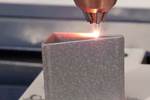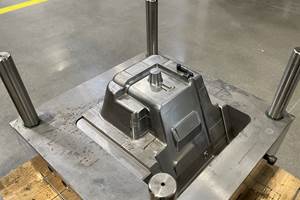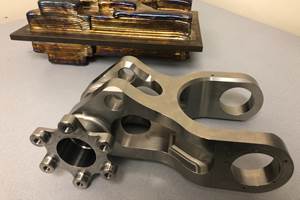Dealing With Dross in Laser Powder Bed Fusion
Researchers in Denmark are uncovering the secrets of meltpool morphology with advanced simulation tools for computational fluid dynamics (CFD).
Share
Read Next
The first laser powder bed fusion (LPBF) machines entered the commercial market in the mid-1990s. They quickly began to pave the way for a revolution in manufacturing and, nearly three decades later, have changed how we produce countless metal components, from fuel nozzles and hip replacements to turbine blades and heat exchangers.
And yet, it wasn’t until quite recently that researchers have started to understand the complex physics that occur when a laser beam barely one human hair in diameter strikes tiny bits of metal powder, instantaneously raising their temperature up to several thousand degrees Fahrenheit and forming what the additive manufacturing (AM) industry refers to as a melt pool.
Dr. Mohamad Bayat is one of these researchers. An associate professor in mechanical engineering at the Technical University of Denmark (DTU), he has spent his entire academic career exploring this miniature realm. The findings emerging from his and other laboratories are poised to change how metal AM machine builders design their wares, and how OEMs and large service bureaus operate them.
The primary tool Bayat uses to model these complex processes is Flow-3D AM, an advanced computational fluid dynamics (CFD) software platform from Flow Science Inc., designed specifically for the simulation of metal and polymer 3D printing processes.
“I was using finite element-based software to simulate meltpool dynamics for my doctoral thesis and found that I was somehow losing particle mass during droplet impingement,” he says. “I was stuck, and even considered pursuing a different aspect of additive manufacturing for my Ph.D. until I spoke to a professor on our team, Dr. Jon Spangenberg. He'd heard good things about a new CFD software from Flow-3D and agreed to purchase a license. We’ve been using it ever since.”
That was in 2018, and Bayat has since published numerous research papers on metal AM using CFD. The Flow-3D software played a role in anticipating 3D printing results in a recently published study, which focused on an effect commonly experienced in LPBF: dross.
In this micrograph, the red line marks the boundary of the CAD design — all the material to its left is dross, excess material on the down-facing surface. Source: Amal Charles, Mohamad Bayat, et al.
Dross Formation in LPBF
In his paper, “Elucidation of dross formation in laser powder bed fusion at down-facing surfaces: Phenomenon-oriented multiphysics simulation and experimental validation,” Bayat explores the causes of dross and correlations between simulation and experimental results.
The problems associated with down-facing surfaces are well-known in the metal AM community and machine builders have worked diligently to address them. What’s perhaps less understood is the term dross. Long associated with the impurities that form on the surface of molten metals during the smelting, casting and welding processes, it takes on a broader definition when applied to LPBF, directed energy deposition (DED) and certain other high-energy, powder-based metal AM technologies.
“Think of dross as any material that does not adhere to the intended geometry of a down-facing surface,” Bayat says. “For example, if I attempt to print a three-millimeter-thick part feature at a 30-degree angle but instead end up with one that measures five millimeters, this inaccuracy could very well be due to dross. Think of it as frozen droplets of material hanging from the bottom of an overhanging structure.”
As described in Bayat’s paper, dross formation is primarily due to the “low thermal conductivity of loose powder” and subsequent inability to conduct heat away from the melt pool, leading to a “keyhole-like melt mode which causes a pronounced drilling effect.” The result? Dimensional variation, high surface roughness and perhaps most importantly to manufacturers using metal AM for load-bearing components, degraded mechanical properties and defects such as porosity.
This cross-sectional image shows porosity caused by dross on the down-facing surfaces. Source: Amal Charles, Mohamad Bayat, et al.
A Helping Hand
Bayat had help with his research. The paper credits former supervisor Dr. Jesper Hattel along with several colleagues from the Karlsruhe Institute of Technology and Dr. Lore Thijs, manager of materials and process development engineering at 3D Systems Corp.’s facility in Leuven, Belgium. All collaborated on the work, yet it was Thijs and 3D Systems who acted as the project’s industrial partner.
“During my doctoral work, I was part of the EU research organization PAM², which stands for Precision Additive Metal Manufacturing,” Bayat explains. “Lore was a pioneer in this area while attending the University of Leuven and published one of the first papers on the microstructure of metal parts produced by selective laser melting. She currently serves on the board at PAM2 and played an important role in the project’s inception.”
Thijs’ involvement is not surprising, given that accurate, predictable printing of angled, near-horizontal surfaces continues to be the benchmark by which many metal AM systems are measured. Those able to control dross formation can not only produce higher quality parts but also reduce or even eliminate the need for build supports, thus reducing manufacturing costs.
Affirmation Through Simulation
Bayat and his team began the research project by designing tent-shaped test parts roughly one inch across and made of Grade 23 Ti-6Al4V titanium. These were preprocessed using 3D Systems’ 3DXpert build software and transferred to one of the company’s ProX DMP 320 direct metal 3D printers. Standard printing parameters were used except for the down-facing areas, where various levels of laser power were applied, including a “high energy” mode to ensure dross formation. Test samples were then cleaned, sectioned and polished before inspection with optical and scanning electron microscopes.
The keyholing, porosity and inaccuracies found in the physical test samples mimicked those predicted earlier by Flow-3D AM, verifying that the input parameters used in the virtual model were correct. “Advanced simulation helped us discover the underlying mechanism behind these overhang defects, and now that we’ve correlated the two, we can look for ways to correct them. The ultimate goal is to perform real-time adjustments based on in-situ feedback during the build process, although this will require additional work.”
This graphic shows temperature contours in track morphology as predicted by a CFD model compared to the experiment. Source: Amal Charles, Mohamad Bayat, et al.
Until that technology becomes available, Bayat has found that adjustments to the preprogrammed laser path can bring significant benefits. As noted in the paper, laser deceleration at the end of each scan vector is a main contributor to the keyholing effect and “a scan strategy where the laser power is kept off while moving between adjacent laser scans — a so-called skywriting laser path mode — is preferable for reduced dross formation and increased density. Therefore, further research on parameter optimization and development of novel scanning strategies for the down-facing region is required.”
Beyond Dross
Bayat and the team at DTU are using advanced simulation to validate other AM experiments.
An earlier paper discusses how powder stream velocity affects heat and fluid flow conditions in DED, a metal AM technology widely used in component repair, surface enhancement and production of “functionally graded” sandwich-like metals.
Here, models built in Flow-3D AM helped explain various physical phenomena such as solidification, evaporation and the Marangoni effect, described as the physical phenomenon that occurs when there are gradients in surface tension along an interface between two fluids. Using thermal cameras and optical microscopy, DTU researchers showed that the simulations were “in good agreement” with physical measurements. More importantly, the team discovered they could more than double the height-to-width ratios of 3D printed tracks by increasing particle velocity, a finding that could have some otherworldly applications.
“We applied for funding recently on a project called Lunar Print,” he says. “We have actually managed to use a DED-like process to print seven or eight layers of moon sand. If successful, it could enable astronauts to 3D print lunar habitats with the raw materials on hand. As with most of our work here, Flow-3D AM will play a crucial role in validating and guiding our experiments.”
Related Content
Video: Machining and Directed Energy Deposition (DED) Aid One Another and Work Together
DED parts made by a machine tool provider illustrate various ways the strategic consideration of either metal 3D printing or machining helps the other process.
Read MoreDaimler, OMIC Evaluate Wire-Fed DED for Moldmaking
3D printing a core and cavity on machine from Gefertec, followed by machining, allowed for a complete mold tool to be produced in three days.
Read More7 Lessons From General Atomics on AM for Aircraft Part Production
A manufacturing leader overseeing the way additive manufacturing is transforming unmanned aerial systems (UASs) offers observations about succeeding with 3D printing as an aircraft production process.
Read MoreBig Metal Additive: The Difference Between a Shape and a Part Is Quality
Preparing to scale directed energy deposition to ongoing full production is not a technological challenge: DED is ready. But it is an organizational challenge, says the company founder. Here is what it means to implement a quality system.
Read MoreRead Next
Infrared Camera Supports Real-Time Process Control for Laser Metal Deposition and Cladding
New Infrared Technologies’ Clamir system provides continuous meltpool monitoring for cladding and directed energy deposition 3D printing.
Read MoreSpatter, Surrogate Modeling and More Advanced Manufacturing Research Happening at Carnegie Mellon University: AM Radio #53
In this trip report, we discuss research at the Manufacturing Futures Institute and Next Manufacturing Center, both under CMU’s umbrella, to advance industry with robotics, AI and additive manufacturing.
Read MoreGenetic Engineering for Metal: The Promise of Microstructure Control via Additive Manufacturing
“To design the alloy, design the microstructure,” says this Ohio materials science startup. Artificial intelligence is helping to realize a design tool for determining the properties of 3D printed metals.
Read More



















